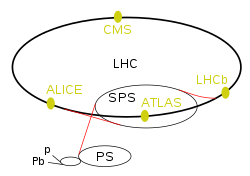ATLAS experiment
 |
|
| LHC experiments | |
|---|---|
| ATLAS | A Toroidal LHC Apparatus |
| CMS | Compact Muon Solenoid |
| LHCb | LHC-beauty |
| ALICE | A Large Ion Collider Experiment |
| TOTEM | Total Cross Section, Elastic Scattering and Diffraction Dissociation |
| LHCf | LHC-forward |
| MoEDAL | Monopole and Exotics Detector At the LHC |
| LHC preaccelerators | |
| p and Pb | Linear accelerators for protons (Linac 2) and Lead (Linac 3) |
| (not marked) | Proton Synchrotron Booster |
| PS | Proton Synchrotron |
| SPS | Super Proton Synchrotron |
Coordinates: 46°14′8″N 6°3′19″E / 46.23556°N 6.05528°E ATLAS (A Toroidal LHC ApparatuS) is one of the seven particle detector experiments (ALICE, ATLAS, CMS, TOTEM, LHCb, LHCf and MoEDAL) constructed at the Large Hadron Collider (LHC), a particle accelerator at CERN (the European Organization for Nuclear Research) in Switzerland. The experiment is designed to take advantage of the unprecedented energy available at the LHC and observe phenomena that involve highly massive particles which were not observable using earlier lower-energy accelerators. It is hoped that it will shed light on new theories of particle physics beyond the Standard Model.
ATLAS is 46 metres long, 25 metres in diameter, and weighs about 7,000 tonnes; it contains some 3000 km of cable. The experiment is a collaboration involving roughly 3,000 physicists from over 175 institutions in 38 countries. The project was led for the first 15 years by Peter Jenni and between 2009 and 2013 was headed by Fabiola Gianotti. Since 2013 it has been headed by David Charlton. From March 2017 onwards it will be led by Karl Jakobs. It was one of the two LHC experiments involved in the discovery of the Higgs boson in July 2012.
...
Wikipedia
